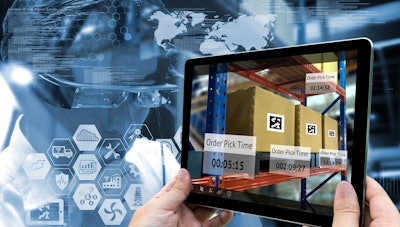
It’s no secret that the Coronavirus disease (COVID-19) represents the largest disruption to global supply chains since the concept of “supply chains” emerged in the 1970s. Equally unprecedented is its disparate impact: With so many consumers staying home, e-commerce boomed, while the travel and hospitality industry flatlined. The result has left manufacturers worldwide scrambling to make their operations more resilient.
That said, much of the mainstream media’s discussion around pandemic’s supply chain drama has ignored an important fact -- disruption has always been a reality in supply chains. Back in 2019, DHL Resilience 360 predicted that trade wars, climate change and container ship fires would be among the top challenges wreaking havoc on supply chains in 2020, and while their list was missing a global pandemic, they weren’t exactly wrong -- the U.S./Chinese trade war and container ship fires did indeed challenge businesses last year.
Unfortunately, trying to implement supply chain resilience during a pandemic is like trying to protect yourself with flood insurance during a hurricane. You can’t flip a switch to prevent the next disaster; you need to clean up the damage from your last one first. A lot of preparation goes into making a supply chain resilient, and if your business is among the many significantly impacted, you’re better off taking a step back and developing a path to resilience that follows the three stages outlined below.
Stage 1: Get through recovery
The most important thing to remember about the recovery stage is that you were (or are) in survival mode. You can only get to the next stage if you survive. With that in mind, consider the following guidelines when developing your own plan for this stage:
· Avoid making too many or unnecessary changes. There’s a reason that early in the pandemic, experts were warning companies to put panic buying into context. Disruptions throw supply chains out of control temporarily, and supply chain optimization is about bringing your supply chain back into control.
· Avoid complex forecasting techniques. Face it – historical data from the last 3-6 years does not account for the pandemic. And, even if you had data from the last pandemic 100 years ago, it wouldn’t be relevant today. During recovery, it’s okay to go back to simple or manual forecasting. Most planning systems were not designed to handle a shock this big, so you have to know when to intervene.
· Practice wargaming. While your business may lack hard data to guide its decisions, it shouldn’t lack people with enough experience to assess the present landscape and suggest how to react. And, the best way your business can choose how to react is wargaming – simulating potential responses to whatever challenges it’s facing.
· When communicating, keep it simple. Leadership plays a key role in getting through recovery. Regardless of how bad things get, you can control two things – how you respond and how you communicate your response. Sticking with and calmly delivering the facts at hand will go a long way towards keeping employees and business partners calm during an emergency. Remember that whatever you say is going to be repeated multiple times, and if you make it even a little complex your initial message will become more confusing every time it’s repeated. So, make it as simple as possible the first time.
· Focus on making the uncomfortable comfortable. The resilience of people never ceases to amaze me – already, many have transitioned from complaining to accepting what is often called the “New Normal.” The sooner you learn to embrace discomfort and manage your operations around it, the sooner you’ll feel normal even if everything isn’t.
Stage 2: Pause for discovery
You might be tempted to skip the discovery stage. After all, it would have been easy enough to add “develop a list of lessons you’ve learned” to the list above and move on.
But, that would be a mistake. When pursuing supply chain resilience, it’s crucial to pause and consider what the transition entails. More importantly, it helps you remember one of the most important lessons learned during recovery -- identifying the parts of your operations and pieces of information that are most critical to running your business.
It also gives you a chance to review the number of problems you need to solve and choose which to focus on rather than trying to solve them all at once. Focus on what’s most important, a tip that may sound self-evident, but is too easily lost in the post-recovery fog.
Finally, it’s important that you identify the critical data that helped your company the most during its recovery and the problems it helped solve.
Also consider the information or tools you didn’t have, whether it was related to suppliers, transportation service providers, production capacity and/or inventory levels. Regardless of the maturity of your digital transformation, this is a great time to assess and evaluate the benefits that a digital model of your supply chain would have delivered with the ability to run simulations and scenarios that would have helped your recovery proceed more smoothly.
The discovery stage is best summarized as clearly capturing and appropriately evaluating lessons learned. If you neglect to capture what you’ve learned, you risk forgetting the lessons – or worse, having to learn them again the next time a crisis rolls around.
Stage 3: Steps to resiliency
First, let’s define what resiliency is and what it isn’t. It’s not planning for a future that will be similar to the way everything was because the scale and scope of COVID-19 has already made it clear the post-pandemic future is going to be different.
Instead, it’s about preparing for an uncertain future that we recognize will be different in unknown but significant ways. Here are some guidelines to keep in mind:
· Don’t put off resiliency planning just because things are better now. It’s very human to think that since the floodwaters have receded, we’re free to focus on our newest challenges and can invest in flood insurance once we’ve taken care of them. But, just like flood insurance, it remains critical that you invest in supply chain resilience before the next emergency.
· Commit to improving your digital supply chain. This step can mean different things for different organizations. For example, capturing the data needed and analyzing it for insights, or expanding the ability to capture your supply chain in digital form. Your best bet is to target the part of your operations that is most critical, ensure its resilience, then build from there.
· Don’t conflate resilience with simplicity. Some say the complexity of extended supply chains has resulted in lower resiliency. While there may be some truth to this, the opposite – i.e. simplicity leads to higher resiliency – is not true. It’s undeniable that single sourcing is simpler than multi-sourcing. But, it’s not resilient because you have created a single point of failure. If you want a more resilient supply chain, you may need to increase complexity to minimize or eliminate single points of failure.
· Incorporate optimization models into your operations. To a great extent, building resilience really is like buying insurance – you’ll need to incorporate it into your budget. That doesn’t mean your extra costs will rise in a linear fashion – they could go up by 5% while boosting your network resiliency by 50%. That investment will pay off when disruptions happen (and they will), by allowing your operations to adapt and respond faster. But, to get there, your organization will need to run scenarios to test for solutions to network disruptions. There is no method of scenario response planning better than optimization models because optimization models don’t base their results on what did happen, they base their projections on what could happen. And, you’ll need to plan for a lot of scenarios to build a resilient network.
· Remember that one size does not fit all. Whatever your company’s solution turns out to be, remember that it’s likely to be unique to your organization. We can learn from each other, but what works in one area is not guaranteed to work in another.
Delivering the goods
Remember the importance of simplicity during recovery, don’t ignore discovery and commit to building resilience.
That way, when the next set of supply chain disruptions come to knock you down, you’ll be able to work through or around the disruption faster, better and smarter.


















